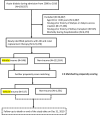Long-term outcomes following vehicle trauma related acute kidney injury requiring renal replacement therapy: a nationwide population study
- PMID: 33239657
- PMCID: PMC7689526
- DOI: 10.1038/s41598-020-77556-3
Long-term outcomes following vehicle trauma related acute kidney injury requiring renal replacement therapy: a nationwide population study
Abstract
Acute kidney injury (AKI) is a frequent complication of traumatic injury; however, long-term outcomes such as mortality and end-stage kidney disease (ESKD) have been rarely reported in this important patient population. We compared the long-term outcome of vehicle-traumatic and non-traumatic AKI requiring renal replacement therapy (AKI-RRT). This nationwide cohort study used data from the Taiwan National Health Insurance Research Database. Vehicle-trauma patients who were suffered from vehicle accidents developing AKI-RRT during hospitalization were identified, and matching non-traumatic AKI-RRT patients were identified between 2000 and 2010. The incidences of ESKD, 30-day, and long-term mortality were evaluated, and clinical and demographic associations with these outcomes were identified using Cox proportional hazards regression models. 546 vehicle-traumatic AKI-RRT patients, median age 47.6 years (interquartile range: 29.0-64.3) and 76.4% male, were identified. Compared to non-traumatic AKI-RRT, vehicle-traumatic AKI-RRT patients had longer length of stay in hospital [median (IQR):15 (5-34) days vs. 6 (3-11) days; p < 0.001). After propensity matching with non-traumatic AKI-RRT cases with similar demographic and clinical characteristics. Vehicle-traumatic AKI-RRT patients had lower rates of long-term mortality (adjusted hazard ratio (HR), 0.473; 95% CI, 0.392-0.571; p < 0.001), but similar rates of ESKD (HR, 1.166; 95% CI, 0.829-1.638; p = 0.377) and short-term risk of death (HR, 1.134; 95% CI, 0.894-1.438; p = 0.301) as non-traumatic AKI-RRT patients. In competing risk models that focused on ESKD, vehicle-traumatic AKI-RRT patients were associated with lower ESKD rates (HR, 0.552; 95% CI, 0.325-0.937; p = 0.028) than non-traumatic AKI-RRT patients. Despite severe injuries, vehicle-traumatic AKI-RRT patients had better long-term survival than non-traumatic AKI-RRT patients, but a similar risk of ESKD. Our results provide a better understanding of long-term outcomes after vehicle-traumatic AKI-RRT.
Conflict of interest statement
The authors declare no competing interests.
Figures



Similar articles
-
[Analysis of the characteristics of patients suffering from acute kidney injury following severe trauma receiving renal replacement therapy].Zhonghua Wei Zhong Bing Ji Jiu Yi Xue. 2015 May;27(5):349-53. doi: 10.3760/cma.j.issn.2095-4352.2015.05.006. Zhonghua Wei Zhong Bing Ji Jiu Yi Xue. 2015. PMID: 26003638 Chinese.
-
Long-term outcome in ICU patients with acute kidney injury treated with renal replacement therapy: a prospective cohort study.Crit Care. 2016 Aug 12;20(1):256. doi: 10.1186/s13054-016-1409-z. Crit Care. 2016. PMID: 27520553 Free PMC article.
-
Predictive Factors Upon Discontinuation of Renal Replacement Therapy for Long-Term Chronic Dialysis and Death in Acute Kidney Injury Patients.Artif Organs. 2017 Dec;41(12):1127-1134. doi: 10.1111/aor.12927. Epub 2017 May 23. Artif Organs. 2017. PMID: 28544060
-
Early versus late initiation of renal replacement therapy in patients with acute kidney injury-a systematic review & meta-analysis of randomized controlled trials.BMC Nephrol. 2017 Feb 28;18(1):78. doi: 10.1186/s12882-017-0486-9. BMC Nephrol. 2017. PMID: 28245793 Free PMC article.
-
Early strategy vs. late initiation of renal replacement therapy in adult patients with acute kidney injury: an updated systematic review and meta-analysis of randomized controlled trials.Eur Rev Med Pharmacol Sci. 2023 Jul;27(13):6046-6057. doi: 10.26355/eurrev_202307_32959. Eur Rev Med Pharmacol Sci. 2023. PMID: 37458646
References
Publication types
MeSH terms
LinkOut - more resources
Full Text Sources

